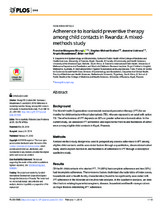| dc.contributor.author | Birungi, Francine Mwayuma | |
| dc.contributor.author | Graham, Stephen Michael | |
| dc.contributor.author | Uwimana, Jeannine | |
| dc.date.accessioned | 2021-07-06T09:22:13Z | |
| dc.date.available | 2021-07-06T09:22:13Z | |
| dc.date.issued | 2019 | |
| dc.identifier.citation | Birungi, F.M. et al., 2019). Adherence to isoniazid preventive therapy among child contacts in Rwanda: A mixed-methods study. PLoS ONE, 14(2), 1–16. https://doi.org/10.1371/journal.pone.0211934 | en_US |
| dc.identifier.issn | 1932-6203 | |
| dc.identifier.uri | https://doi.org/10.1371/journal.pone.0211934 | |
| dc.identifier.uri | http://hdl.handle.net/10566/6360 | |
| dc.description.abstract | The World Health Organization recommends isoniazid preventive therapy (IPT) for six months for child contacts without tuberculosis (TB), who are exposed to an adult with active TB. The effectiveness of IPT depends on 80% or greater adherence to medication. In the current study, we assessed IPT adherence and explored barriers to and facilitators of adherence among eligible child contacts in Kigali, Rwanda.A mixed method study design was used to prospectively assess adherence to IPT among eligible child contacts and its associated factors through a quantitative, observational cohort study, and to explore barriers to and facilitators of adherence to IPT through a descriptive qualitative study. | en_US |
| dc.language.iso | en | en_US |
| dc.publisher | Public Library of Science | en_US |
| dc.subject | Isoniazid | en_US |
| dc.subject | Therapy | en_US |
| dc.subject | Child contacts | en_US |
| dc.subject | Rwanda | en_US |
| dc.subject | Tuberculosis (TB) | en_US |
| dc.subject | Poverty and relocation | en_US |
| dc.title | Adherence to isoniazid preventive therapy among child contacts in Rwanda: A mixed-methods study | en_US |
| dc.type | Article | en_US |

